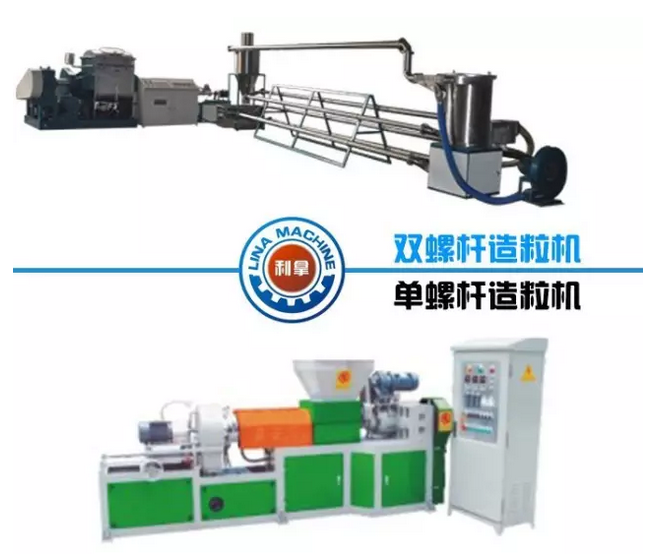
Privacy statement: Your privacy is very important to Us. Our company promises not to disclose your personal information to any external company with out your explicit permission.
What is the difference between single screw and double screw granulation line?
(1). Let's take a look at the difference between single screw granulator and twin screw granulator from working principle:
Single Screw Granulator: Material through the feed port, under the action of the rotating screw, is ramming into a group and rolling forward along the screw groove, due to the screw shear, compression and mixing, the material is further mixed and plasticized, the temperature and pressure gradually rise High, showing a viscous flow state, passing the head with a certain pressure and temperature, and finally obtaining a product of a desired shape.
Twin Screw Granulator: The material is fed into the double-cone feeder through an automatic hoist and the conical material is forced into the main screw. The material is subjected to mixing and compression under the action of screw compression and shearing and external heating. Plasticization. The temperature and pressure gradually increase, showing a viscous flow state, and passing the machine head through a certain pressure, extruding and pelletizing, finally obtaining particles of a desired shape.
(2). The difference between single screw granulator and twin screw granulator uses:
Singe-screw granulation line: Single screw extruder is mainly used for the filling, blending, modification, addition, chlorination, polypropylene and super-absorbent resin processing of rubber and engineering resins, degradable masterbatch, polyamide polycondensation, polyurethane plus Extrusion of polyreaction, granulation of carbon powder and magnetic powder, insulation material for cable, jacket material, low-smoke halogen-free flame-retardant PVC cable material and preparation of various saline cross-linking materials.
Double-screw granulation line: Twin-screw granulator is mainly used for the filling, blending, modification, addition, chlorination, polypropylene and superabsorbent resin processing of rubber and plastics and engineering resins, degradable masterbatch, polyamide polycondensation, polyurethane plus Extrusion of polyreaction, granulation of carbon powder and magnetic powder, insulation material for cable, jacket material, low-smoke halogen-free flame-retardant PVC cable material and preparation of various silane crosslinking materials, etc.

(3). The main difference between twin screw granulator and single screw granulator:
1. The twin-screw granulator consists of two screws that are in close contact with each other.
2. The material of the twin-screw granulator is conveyed in a forward direction. The degree of displacement depends on the proximity of the screw groove of one screw to the other, so that the material in the tightly meshed counter-rotating screw can be maximized. Positive displacement.
3. The material delivery speed distribution in the twin-screw granulator is much more complex than the single-screw extruder.
(4). Compared with the single-screw Plastic Granulator, the twin-screw granulator has the following characteristics in the granulation molding process:
1. The material feed efficiency of the single screw depends on the friction properties of the solid material and the viscosity of the melt. In twin-screw extruders, the material is transported on the principle of positive displacement and no back pressure is generated. Therefore, the material is easier to add than the single screw extruder.
2. Due to the short screw length of the twin-screw granulation extruder, the residence time of the material in the twin-screw extruder is short. This can avoid the occurrence of thermal degradation of the recycled fiber and reduce power consumption.
3. The material is sheared and mixed vertically and horizontally to achieve excellent homogenization and plasticization.
4. Excellent exhaust and self-cleaning.
5. The twin-screw pelletizing extruder's flow rate is insensitive to die pressure and is useful for extruding large size and area products. The flow rate of a single-screw pelletizing extruder is sensitive to die pressure.

Privacy statement: Your privacy is very important to Us. Our company promises not to disclose your personal information to any external company with out your explicit permission.

Fill in more information so that we can get in touch with you faster
Privacy statement: Your privacy is very important to Us. Our company promises not to disclose your personal information to any external company with out your explicit permission.